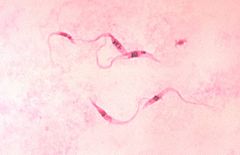Kinetoplastid facts for kids
Quick facts for kids Kinetoplastids |
|
|---|---|
 |
|
| Trypanosoma cruzi parasites | |
| Scientific classification | |
| Domain: | |
| Kingdom: | |
| Phylum: | |
| Class: |
Kinetoplastida
|
| Orders | |
|
Trypanosomatida |
|
The kinetoplastids are a group of single-cell flagellate eukaryotes. They include a number of parasites responsible for serious diseases in humans and other animals. There are also forms found in soil and aquatic environments. They are members of the phylum Euglenozoa.
Their main distinguishing feature is the presence of a kinetoplast, a DNA-containing granule inside the single mitochondrion at the base of the cell's flagella (the basal body).
The kinetoplastids were first defined by Honigberg in 1961 as the flagellate order Kinetoplastida. They are traditionally divided into the biflagellate Bodonidae and uniflagellate Trypanosomatidae.
The Trypanosomatidae includes several genera which are exclusively parasitic. Trypanosoma brucei causes Sleeping sickness; Trypanosoma cruzi causes Chagas disease, Leishmania causes leishmaniasis, Crithidia is parasitic on insects, and Cryptobia is an ectoparasite on the gills of fish.
Bodo is typical of the free-living Bodonids, and includes various species which feed on bacteria.
Images for kids
-
Trypanosoma sp.
See also
 In Spanish: Kinetoplastea para niños
In Spanish: Kinetoplastea para niños




